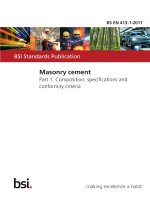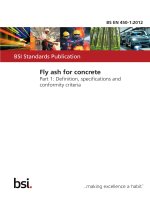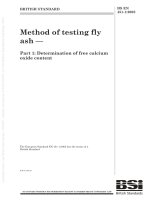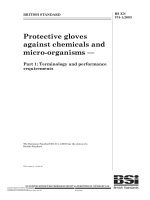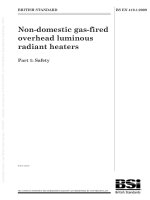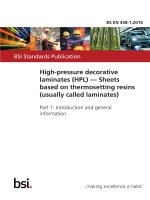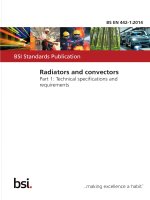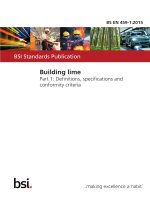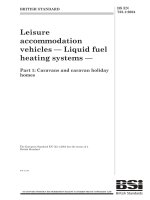Bsi bs en 62453 1 2017
Bạn đang xem bản rút gọn của tài liệu. Xem và tải ngay bản đầy đủ của tài liệu tại đây (3.77 MB, 48 trang )
BS EN 62453-1:2017
BSI Standards Publication
Field Device Tool (FDT)
Interface Specification
Part 1: Overview and guidance (IEC 62453-1:2016)
BRITISH STANDARD
BS EN 62453-1:2017
National foreword
This British Standard is the UK implementation of EN 62453-1:2017. It is
identical to IEC 62453-1:2016. It supersedes BS EN 62453-1:2009 which is
withdrawn.
The UK participation in its preparation was entrusted to Technical Committee AMT/7, Industrial communications: process measurement and
control, including fieldbus.
A list of organizations represented on this committee can be obtained on
request to its secretary.
This publication does not purport to include all the necessary provisions of
a contract. Users are responsible for its correct application.
© The British Standards Institution 2017.
Published by BSI Standards Limited 2017
ISBN 978 0 580 85066 0
ICS 25.040.40; 35.100.05; 35.110
Compliance with a British Standard cannot confer immunity from
legal obligations.
This Published Document was published under the authority of the
Standards Policy and Strategy Committee on 30 April 2017.
Amendments/corrigenda issued since publication
Date
Text affected
BS EN 62453-1:2017
EUROPEAN STANDARD
EN 62453-1
NORME EUROPÉENNE
EUROPÄISCHE NORM
March 2017
ICS 25.040.40; 35.100.05; 35.110
Supersedes EN 62453-1:2009
English Version
Field Device Tool (FDT) interface specification - Part 1:
Overview and guidance
(IEC 62453-1:2016)
Spécification des interfaces des outils des dispositifs de
terrain (FDT) - Partie 1: Vue d'ensemble et guide
(IEC 62453-1:2016)
Field Device Tool (FDT)-Schnittstellenspezifikation - Teil 1:
Überblick und Leitfaden - Teil 1: Überblick und Leitfaden
(IEC 62453-1:2016)
This European Standard was approved by CENELEC on 2017-01-20. CENELEC members are bound to comply with the CEN/CENELEC
Internal Regulations which stipulate the conditions for giving this European Standard the status of a national standard without any alteration.
Up-to-date lists and bibliographical references concerning such national standards may be obtained on application to the CEN-CENELEC
Management Centre or to any CENELEC member.
This European Standard exists in three official versions (English, French, German). A version in any other language made by translation
under the responsibility of a CENELEC member into its own language and notified to the CEN-CENELEC Management Centre has the
same status as the official versions.
CENELEC members are the national electrotechnical committees of Austria, Belgium, Bulgaria, Croatia, Cyprus, the Czech Republic,
Denmark, Estonia, Finland, Former Yugoslav Republic of Macedonia, France, Germany, Greece, Hungary, Iceland, Ireland, Italy, Latvia,
Lithuania, Luxembourg, Malta, the Netherlands, Norway, Poland, Portugal, Romania, Serbia, Slovakia, Slovenia, Spain, Sweden,
Switzerland, Turkey and the United Kingdom.
European Committee for Electrotechnical Standardization
Comité Européen de Normalisation Electrotechnique
Europäisches Komitee für Elektrotechnische Normung
CEN-CENELEC Management Centre: Avenue Marnix 17, B-1000 Brussels
© 2017 CENELEC All rights of exploitation in any form and by any means reserved worldwide for CENELEC Members.
Ref. No. EN 62453-1:2017 E
BS EN 62453-1:2017
EN 62453-1:2017
European foreword
The text of document 65E/333/CDV, future edition 2 of IEC 62453-1, prepared by SC 65E “Devices
and integration in enterprise systems” of IEC/TC 65 “Industrial process measurement, control and
automation" was submitted to the IEC-CENELEC parallel vote and approved by CENELEC as
EN 62453-1:2017.
The following dates are fixed:
•
latest date by which the document has to be
implemented at national level by
publication of an identical national
standard or by endorsement
(dop)
2017-10-20
•
latest date by which the national
standards conflicting with the
document have to be withdrawn
(dow)
2020-01-20
This document supersedes EN 62453-1:2009.
Attention is drawn to the possibility that some of the elements of this document may be the subject of
patent rights. CENELEC [and/or CEN] shall not be held responsible for identifying any or all such
patent rights.
Endorsement notice
The text of the International Standard IEC 62453-1:2016 was approved by CENELEC as a European
Standard without any modification.
In the official version, for Bibliography, the following notes have to be added for the standards
indicated:
2
IEC 61131 (Series)
NOTE
Harmonized as EN 61131 (Series)
IEC 61131-3
NOTE
Harmonized as EN 61131-3
IEC 61158-1
NOTE
Harmonized as EN 61158-1
IEC 61375-3-3
NOTE
Harmonized as EN 61375-3-3
IEC 61499 (Series)
NOTE
Harmonized as EN 61499 (Series)
IEC 61499-1
NOTE
Harmonized as EN 61499-1
IEC 61784-1
NOTE
Harmonized as EN 61784-1
IEC 61784-2
NOTE
Harmonized as EN 61784-2
IEC 61784 (Series)
NOTE
Harmonized as EN 61784 (Series)
IEC 61800-7-1
NOTE
Harmonized as EN 61800-7-1
IEC 61800-7-2 (Series)
NOTE
Harmonized as EN 61800-7-2 (Series)
IEC 61800-7-3 (Series)
NOTE
Harmonized as EN 61800-7-3 (Series)
IEC 61804-2
NOTE
Harmonized as EN 61804-2
BS EN 62453-1:2017
EN 62453-1:2017
IEC 61804-3
NOTE
Harmonized as EN 61804-3
IEC 61804-4
NOTE
Harmonized as EN 61804-4
IEC 61850 (Series)
NOTE
Harmonized as EN 61850 (Series)
IEC 61915-1
NOTE
Harmonized as EN 61915-1
IEC/TS 61970-2
NOTE
Harmonized as CLC/TS 61970-2
IEC 62026 (Series)
NOTE
Harmonized as EN 62026 (Series)
IEC 62026-1
NOTE
Harmonized as EN 62026-1
IEC 62264 (Series)
NOTE
Harmonized as EN 62264 (Series)
IEC 62402
NOTE
Harmonized as EN 62402
IEC 62453 (Series)
NOTE
Harmonized as EN 62453 (Series)
IEC 62541 (Series)
NOTE
Harmonized as EN 62541 (Series)
IEC/TR 62541-1
NOTE
Harmonized as CLC/TR 62541-1
IEC 62769 (Series)
NOTE
Harmonized as EN 62769 (Series)
3
BS EN 62453-1:2017
EN 62453-1:2017
Annex ZA
(normative)
Normative references to international publications
with their corresponding European publications
The following documents, in whole or in part, are normatively referenced in this document and are
indispensable for its application. For dated references, only the edition cited applies. For undated
references, the latest edition of the referenced document (including any amendments) applies.
NOTE 1 When an International Publication has been modified by common modifications, indicated by (mod), the relevant
EN/HD applies.
NOTE 2 Up-to-date information on the latest versions of the European Standards listed in this annex is available here:
www.cenelec.eu.
Publication
IEC 61158
Year
series
IEC 61784
series
4
Title
Industrial communication networks Fieldbus specifications
Industrial communication networks Profiles
EN/HD
EN 61158
Year
series
EN 61784
series
BS EN 62453-1:2017
–2–
IEC 62453-1:2016 IEC 2016
CONTENTS
FOREWORD ........................................................................................................................... 5
INTRODUCTION ..................................................................................................................... 7
1
Scope .............................................................................................................................. 8
2
Normative references ...................................................................................................... 8
3
Terms, definitions, symbols, abbreviations and conventions ............................................ 8
3.1
3.2
3.3
4
FDT
Terms and definitions .............................................................................................. 8
Abbreviations ........................................................................................................ 13
Conventions .......................................................................................................... 14
overview ................................................................................................................ 14
4.1
State of the art ...................................................................................................... 14
4.2
Objectives of FDT ................................................................................................. 15
4.2.1
General features ............................................................................................ 15
4.2.2
Device and module manufacturer benefits ..................................................... 15
4.2.3
System manufacturer and integrator benefits ................................................. 16
4.2.4
Other applications ......................................................................................... 16
4.3
FDT model ............................................................................................................ 16
4.3.1
General ......................................................................................................... 16
4.3.2
Frame Applications ........................................................................................ 18
4.3.3
Device Type Manager .................................................................................... 19
4.3.4
Communication Channel concept ................................................................... 20
4.3.5
Presentation object ........................................................................................ 22
5
Structure of the IEC 62453 series .................................................................................. 22
5.1
5.2
5.3
5.3.1
5.3.2
5.3.3
5.3.4
5.3.5
5.3.6
5.3.7
5.3.8
5.4
5.4.1
5.4.2
5.4.3
5.5
5.5.1
5.5.2
5.5.3
5.5.4
5.5.5
Structure overview ................................................................................................ 22
Part 2 – Concepts and detailed description ........................................................... 24
Parts 3xy – Communication profile integration ...................................................... 24
General ......................................................................................................... 24
Communication profile integration – IEC 61784 CPF 1 ................................... 25
Communication profile integration – IEC 61784 CPF 2 ................................... 25
Communication profile integration – IEC 61784 CP 3/1 and 3/2 ..................... 25
Communication profile integration – IEC 61784 CP 3/4, CP 3/5 and 3/6 ......... 25
Communication profile integration – IEC 61784 CPF 6 ................................... 25
Communication profile integration – IEC 61784 CPF 9 ................................... 25
Communication profile integration – IEC 61784 CPF 15 ................................. 25
Parts 4z – Object model integration profiles .......................................................... 26
General ......................................................................................................... 26
Object model integration profile – Common object model (COM) ................... 26
Object model integration profile – Common language infrastructure
(CLI) .............................................................................................................. 26
Parts 51-xy/52-xy – Communication profile implementation ................................... 26
General ......................................................................................................... 26
Communication profile implementation – IEC 61784 CPF 1............................ 26
Communication profile implementation – IEC 61784 CPF 2............................ 26
Communication profile implementation – IEC 61784 CP 3/1 and 3/2 .............. 27
Communication profile implementation – IEC 61784 CP 3/4, CP 3/5 and
3/6 ................................................................................................................. 27
BS EN 62453-1:2017
IEC 62453-1:2016 IEC 2016
–3–
5.5.6
Communication profile implementation – IEC 61784 CPF 6............................ 27
5.5.7
Communication profile implementation – IEC 61784 CPF 9............................ 27
5.5.8
Communication profile implementation – IEC 61784 CPF 15 .......................... 27
5.6
Parts 6z – DTM styleguides .................................................................................. 27
5.6.1
General ......................................................................................................... 27
5.6.2
Device Type Manager (DTM) styleguide for common object model ................ 27
5.6.3
Field Device Tool (FDT) styleguide for common language infrastructure ........ 27
6
Relation of the IEC 62453 series to other standardization activities ............................... 27
7
Migration to DTM ........................................................................................................... 31
8
How to read IEC 62453 .................................................................................................. 32
8.1
8.2
8.3
8.4
Annex A
Architecture .......................................................................................................... 32
Dynamic behavior ................................................................................................. 32
Structured data types ............................................................................................ 33
Fieldbus communication........................................................................................ 33
(informative) UML notation ..................................................................................... 34
A.1
A.2
A.3
A.4
A.5
Annex B
General ................................................................................................................. 34
Class diagram ....................................................................................................... 34
Statechart diagram................................................................................................ 36
Use case diagram ................................................................................................. 37
Sequence diagram ................................................................................................ 38
(informative) Implementation policy ........................................................................ 39
Bibliography .......................................................................................................................... 40
Figure 1 − Different tools and fieldbuses result in limited integration ..................................... 15
Figure 2 – Full integration of all devices and modules into a homogeneous system ............... 16
Figure 3 – General architecture and components .................................................................. 17
Figure 4 – FDT software architecture .................................................................................... 19
Figure 5 – General FDT client/server relationship ................................................................. 20
Figure 6 – Typical FDT channel architecture ......................................................................... 21
Figure 7 – Channel/parameter relationship ............................................................................ 22
Figure 8 – Structure of the IEC 62453 series ........................................................................ 23
Figure 9 – Standards related to IEC 62453 in an automation hierarchy ................................. 28
Figure 10 – Standards related to IEC 62453 – Grouped by purpose ...................................... 31
Figure 11 – DTM implementations ......................................................................................... 32
Figure A.1 – Note.................................................................................................................. 34
Figure A.2 – Class ................................................................................................................ 34
Figure A.3 – Association ....................................................................................................... 34
Figure A.4 – Composition ...................................................................................................... 35
Figure A.5 – Aggregation ...................................................................................................... 35
Figure A.6 – Dependency...................................................................................................... 35
Figure A.7 – Abstract class, generalization and interface ...................................................... 35
Figure A.8 – Multiplicity ........................................................................................................ 36
Figure A.9 – Elements of UML statechart diagrams ............................................................... 36
BS EN 62453-1:2017
–4–
IEC 62453-1:2016 IEC 2016
Figure A.10 – Example of UML state chart diagram............................................................... 37
Figure A.11 – UML use case syntax ...................................................................................... 37
Figure A.12 – UML sequence diagram .................................................................................. 38
Table 1 – Overview of related standards ............................................................................... 29
BS EN 62453-1:2017
IEC 62453-1:2016 IEC 2016
–5–
INTERNATIONAL ELECTROTECHNICAL COMMISSION
____________
FIELD DEVICE TOOL (FDT) INTERFACE SPECIFICATION –
Part 1: Overview and guidance
FOREWORD
1) The International Electrotechnical Commission (IEC) is a worldwide organization for standardization comprising
all national electrotechnical committees (IEC National Committees). The object of IEC is to promote
international co-operation on all questions concerning standardization in the electrical and electronic fields. To
this end and in addition to other activities, IEC publishes International Standards, Technical Specifications,
Technical Reports, Publicly Available Specifications (PAS) and Guides (hereafter referred to as “IEC
Publication(s)”). Their preparation is entrusted to technical committees; any IEC National Committee interested
in the subject dealt with may participate in this preparatory work. International, governmental and nongovernmental organizations liaising with the IEC also participate in this preparation. IEC collaborates closely
with the International Organization for Standardization (ISO) in accordance with conditions determined by
agreement between the two organizations.
2) The formal decisions or agreements of IEC on technical matters express, as nearly as possible, an international
consensus of opinion on the relevant subjects since each technical committee has representation from all
interested IEC National Committees.
3) IEC Publications have the form of recommendations for international use and are accepted by IEC National
Committees in that sense. While all reasonable efforts are made to ensure that the technical content of IEC
Publications is accurate, IEC cannot be held responsible for the way in which they are used or for any
misinterpretation by any end user.
4) In order to promote international uniformity, IEC National Committees undertake to apply IEC Publications
transparently to the maximum extent possible in their national and regional publications. Any divergence
between any IEC Publication and the corresponding national or regional publication shall be clearly indicated in
the latter.
5) IEC itself does not provide any attestation of conformity. Independent certification bodies provide conformity
assessment services and, in some areas, access to IEC marks of conformity. IEC is not responsible for any
services carried out by independent certification bodies.
6) All users should ensure that they have the latest edition of this publication.
7) No liability shall attach to IEC or its directors, employees, servants or agents including individual experts and
members of its technical committees and IEC National Committees for any personal injury, property damage or
other damage of any nature whatsoever, whether direct or indirect, or for costs (including legal fees) and
expenses arising out of the publication, use of, or reliance upon, this IEC Publication or any other IEC
Publications.
8) Attention is drawn to the Normative references cited in this publication. Use of the referenced publications is
indispensable for the correct application of this publication.
9) Attention is drawn to the possibility that some of the elements of this IEC Publication may be the subject of
patent rights. IEC shall not be held responsible for identifying any or all such patent rights.
International Standard IEC 62453-1 has been prepared by subcommittee 65E: Devices and
integration in enterprise systems, of IEC technical committee 65: Industrial-process
measurement, control and automation.
This second edition cancels and replaces the first edition published in 2009. This edition
constitutes a technical revision.
This edition includes the following significant technical changes with respect to the previous
edition: introduction of a new implementation technology (defined in IEC 62453-42).
BS EN 62453-1:2017
–6–
IEC 62453-1:2016 IEC 2016
The text of this standard is based on the following documents:
CDV
Report on voting
65E/333/CDV
65E/393A/RVC
Full information on the voting for the approval of this standard can be found in the report on
voting indicated in the above table.
This publication has been drafted in accordance with the ISO/IEC Directives, Part 2.
A list of all parts of the IEC 62453 series, under the general title Field Device Tool (FDT)
interface specification, can be found on the IEC website.
The committee has decided that the contents of this publication will remain unchanged until
the stability date indicated on the IEC web site under "" in the data
related to the specific publication. At this date, the publication will be
•
reconfirmed,
•
withdrawn,
•
replaced by a revised edition, or
•
amended.
IMPORTANT – The 'colour inside' logo on the cover page of this publication indicates
that it contains colours which are considered to be useful for the correct
understanding of its contents. Users should therefore print this document using a
colour printer.
BS EN 62453-1:2017
IEC 62453-1:2016 IEC 2016
–7–
INTRODUCTION
Enterprise automation requires two main data flows: a “vertical” data flow from enterprise
level down to the field devices including signals and configuration data, and a “horizontal”
communication between field devices operating on the same or different communication
technologies.
With the integration of fieldbuses into control systems, there are a few additional tasks to be
performed. The may result in a large number of fieldbus- and device-specific tools in addition
to system and engineering tools. Integration of these tools into higher-level system-wide
planning or engineering tools is an advantage. In particular, for use in extensive and
heterogeneous control systems, typically in the area of the process industry, the unambiguous
definition of engineering interfaces that are easy to use for all those involved is of great
importance.
Several different manufacturer specific tools are used. The data in these tools are often
invisible data islands from the viewpoint of system life-cycle management and plant-wide
automation.
To ensure the consistent management of a plant-wide control and automation technology, it is
important to fully integrate fieldbuses, devices and sub-systems as a seamless part of a wide
range of automation tasks covering the whole automation life-cycle.
IEC 62453 provides an interface specification for developers of FDT (Field Device Tool)
components to support function control and data access within a client/server architecture.
The availability of this standard interface facilitates development of servers and clients by
multiple manufacturers and supports open interoperation.
A device or module-specific software component, called a DTM (Device Type Manager) is
supplied by a manufacturer with the related device type or software entity type. Each DTM
can be integrated into engineering tools via defined FDT interfaces. This approach to
integration is in general open for all fieldbusses and thus supports integration of different
devices and software modules into heterogeneous control systems.
The IEC 62453 common application interface supports the interests of application developers,
system integrators, and manufacturers of field devices and network components. It also
simplifies procurement, reduces system costs and helps manage the lifecycle. Significant
savings are available in operating, engineering and maintaining the control systems.
The objectives of the IEC 62453 series are to support:
•
universal plant-wide tools for life-cycle management of heterogeneous fieldbus
environments, multi-manufacturer devices, function blocks and modular sub-systems for
all automation domains (e.g. process automation, factory automation and similar
monitoring and control applications);
•
integrated and consistent life-cycle data exchange within a control system including its
fieldbuses, devices, function blocks and modular sub-systems;
•
simple and powerful manufacturer-independent integration of different automation devices,
function blocks and modular sub-systems into the life-cycle management tools of a control
system.
The FDT concept supports planning and integration of monitoring and control applications, it
does not provide a solution for other engineering tasks such as "electrical wiring planning”,
“mechanical planning”. Plant management subjects such as "maintenance planning”, “control
optimization”, “data archiving”, are not part of this FDT standard. Some of these aspects may
be included in future editions of FDT publications.
BS EN 62453-1:2017
–8–
IEC 62453-1:2016 IEC 2016
FIELD DEVICE TOOL (FDT) INTERFACE SPECIFICATION –
Part 1: Overview and guidance
1
Scope
This part of IEC 62453 presents an overview and guidance for the IEC 62453 series. It
•
explains the structure and content of the IEC 62453 series (see Clause 5);
•
provides explanations of some aspects of the IEC 62453 series that are common to many
of the parts of the series;
•
describes the relationship to some other standards.
2
Normative references
The following documents, in whole or in part, are normatively referenced in this document and
are indispensable for its application. For dated references, only the edition cited applies. For
undated references, the latest edition of the referenced document (including any
amendments) applies.
IEC 61158 (all parts), Industrial communication networks – Fieldbus specifications
IEC 61784 (all parts), Industrial communication networks – Profiles
3
Terms, definitions, symbols, abbreviations and conventions
For the purposes of this document the following terms, definitions, abbreviations and
conventions apply.
3.1
Terms and definitions
3.1.1
actor
coherent set of roles that users of use cases play when interacting with these use cases
Note 1 to entry:
An actor has one role for each use case with which it communicates.
[SOURCE: ISO/IEC 19501:2005, 4.11.2.1]
3.1.2
address
communication protocol specific access identifier
3.1.3
application
software functional unit that is specific to the solution of a problem in industrial-process
measurement and control
Note 1 to entry:
applications.
An application may be distributed among resources, and may communicate with other
BS EN 62453-1:2017
IEC 62453-1:2016 IEC 2016
–9–
3.1.4
business object
object representing specific behavior (e.g. DTM, BTM and channel)
Note 1 to entry: The term business object has been defined originally as part of the design pattern three-tier
architecture, where the business object is part of the business layer.
3.1.5
Block Type Manager
BTM
specialized DTM to manage and handle a block
Note 1 to entry:
This note applies to the French language only.
3.1.6
communication
fieldbus protocol specific data transfer
3.1.7
Communication Channel
access point for communication to field device
3.1.8
configuration
system created by configuring the plant components and the topology
3.1.9
configure
setting parameters at the instance data as well as the logical association of plant components
to build up the plant topology (off-line)
Note 1 to entry:
See also parameterize (3.1.38).
3.1.10
connection
established data path for communication with a selected device
3.1.11
data
set of parameter values
3.1.12
data type
defined set of data objects of a specified data structure and a set of permissible operations,
such that these data objects act as operands in the execution of any one of these operations
[SOURCE: ISO 2382-15.04.01:1999]
3.1.13
DCS manufacturer
system manufacturer
manufacturer of the control system
Note 1 to entry:
This note applies to the French language only.
3.1.14
device
independent physical entity of an automation system capable of performing specified
functions in a particular context and delimited by its interfaces
BS EN 62453-1:2017
– 10 –
IEC 62453-1:2016 IEC 2016
[SOURCE: IEC 61499-1:2012, 3.29, modified – the note has been deleted]
3.1.15
field device
networked independent physical entity of an automation system capable of performing
specified functions in a particular context and delimited by its interfaces
[SOURCE: IEC 61375-3-3:2012, 3.1.3]
3.1.16
device manufacturer
manufacturer of fieldbus devices
3.1.17
device type
device characterization based on abstract properties such as manufacturer, fieldbus protocol,
device type identifier, device classification, version information or other information
Note 1 to entry: The scope of such characterizations can vary depending on the properties that are used in the
definition of such a set and is manufacturer specific for each DTM.
3.1.18
distributed system
FDT objects that jointly are executed on different PCs in a network
Note 1 to entry: The implementation of such a distributed system is vendor specific (for example: DTM and
Presentation are executed on different PCs or DTMs are executed in a multi-user system on different PCs).
Note 2 to entry:
This note applies to the French language only.
3.1.19
documentation
human readable information about a device instance
Note 1 to entry:
This may be electronic information in a database.
3.1.20
Device Type Manager
DTM
software component containing device-specific application software
Note 1 to entry: The DTM is a generic class and means "Type Manager". The D is kept because the acronym is
well-known in the market.
Note 2 to entry:
This note applies to the French language only.
3.1.21
DTM device type
software module for a particular device type within the DTM
Note 1 to entry:
A DTM may contain one or more DTM device types.
3.1.22
entity
particular thing, such as a person, place, process, object, concept, association, or event
[SOURCE: IEC 61499-1:2012, 3.31]
3.1.23
Frame Application
FDT runtime environment
BS EN 62453-1:2017
IEC 62453-1:2016 IEC 2016
– 11 –
3.1.24
FDT model
interface specification for objects and object behavior in a monitoring and control system
3.1.25
function
specific purpose of an entity or its characteristic action
[SOURCE: IEC 61499-1:2012, 3.44]
3.1.26
Generic DTM
DTM which interprets device type or domain specific device descriptions and provides the
FDT interfaces
Note 1 to entry:
This note applies to the French language only.
3.1.27
hardware
physical equipment,
documentation
as
opposed
to
programs,
procedures,
rules
and
associated
[SOURCE: IEC 61499-1:2012, 3.49]
3.1.28
implementation
development phase in which the hardware and software of a system become operational
[SOURCE: IEC 61499-1:2012, 3.51]
3.1.29
instantiation
creation of an instance of a specified type
[SOURCE: IEC 61499-1:2012, 3.57]
3.1.30
interface
shared boundary between two functional units, defined by functional characteristics, signal
characteristics, or other characteristics as appropriate
[SOURCE: IEC 60050-351:2013, 351-42-25]
3.1.31
Interpreter DTM
Generic DTM which interprets device descriptions
3.1.32
mapping
set of features or attributes having defined correspondence with the members of another set
[SOURCE: IEC 61499-1:2012, 3.66]
3.1.33
multi-user environment
environment which allows operation by more than one user
BS EN 62453-1:2017
– 12 –
IEC 62453-1:2016 IEC 2016
3.1.34
network
all of the media, connectors, repeaters, routers, gateways and associated node
communication elements by which a given set of communicating devices are interconnected
Note 1 to entry: In this document network is used to express that one or more interconnected fieldbus systems
with different protocols can be applied.
[SOURCE: IEC 61158-1:2014, 3.1.5]
3.1.35
nested communication
communication using a hierarchy of communication systems
3.1.36
operation
well-defined action that, when applied to any permissible combination of known entities,
produces a new entity
[SOURCE: IEC 61499-1:2012, 3.73]
3.1.37
parameter
variable that is given a constant value for a specified application and that may denote the
application
[SOURCE: IEC 61499-1:2012, 3.75]
3.1.38
parameterize
setting parameters in a device or a block or an object
Note 1 to entry:
See configure (3.1.9).
3.1.39
persistent data
stored data that is preserved through shutdown/restart and maintenance activities
3.1.40
Process Channel
representation of process value and its properties
3.1.41
service
functional capability of a resource which can be modeled by a sequence of service primitives
[SOURCE: IEC 61499-1:2012, 3.87]
3.1.42
session
instance of user interactions within the FDT model
3.1.43
synchronization
synchronization of data depending on the context where used
Note 1 to entry: For example, synchronization can occur between the DTM and the device or between several
DTM instances having a reference to the same instance data.
BS EN 62453-1:2017
IEC 62453-1:2016 IEC 2016
– 13 –
3.1.44
system
set of interrelated elements considered in a defined context as a whole and separated from
their environment
Note 1 to entry: Elements of a system may be natural or man-made material objects, as well as modes of thinking
and the results thereof (for example forms of organization, mathematical methods, and programming languages).
Note 2 to entry: The system is considered to be separated from the environment and other external systems by an
imaginary surface, which can cut the links between them and the considered system.
[SOURCE: IEC 60050-351:2013, 351-42-08, modified – some notes have been deleted]
3.1.45
transient data
temporary data which have not been stored (while configuring or parameterizing)
3.1.46
type
software element which specifies the common attributes shared by all instances of the type
[SOURCE: IEC 61499-1:2012, 3.99]
3.1.47
variable
software entity that may take different values, one at a time
Note 1 to entry:
The values of a variable are usually restricted to a certain data type.
Note 2 to entry:
Variables are described as input variables, output variables, and internal variables.
[SOURCE: IEC 61499-1:2012, 3.102]
3.1.48
use case
class specification of a sequence of actions, including variants, that a system (or other entity)
can perform, interacting with actors of the system
[SOURCE: IEC TR 62390:2005, 3.1.26]
3.2
Abbreviations
BTM
Block Type Manager
CLI
Common Language Infrastructure
COM
Component Object Model
[IEC 62541-1]
CP
Communication profile
[IEC 61784-1]
CPF
Communication profile family
[IEC 61784-1]
DCS
Distributed control system
[IEC 62351-2]
DD
Device description
DTM
Device Type Manager
ERP
Enterprise resource planning
FA
Frame Application
FB
Function block
FDT
Field device tool
GUI
Graphical user interface
ID
Identifier
[IEC 61784-3-3]
BS EN 62453-1:2017
– 14 –
IDL
Interface definition language
I/O
Input/output
IT
Information technology
MES
Manufacturing execution systems
IEC 62453-1:2016 IEC 2016
[ISO/IEC 24775]
[IEC 80001-2-1]
OEM
Original equipment manufacturer
OLE
Object Linking and Embedding
[IEC 61970-2]
OPC
Open connectivity via open standards (originally: OLE for Process Control)
[IEC 61970-2]
PC
Personal computer
[IEC 62481-1]
PLC
Programmable logic controller
[IEC 61131-1]
SCADA
Supervisory, control and data acquisition
[IEC 62443-1-1]
UML
Unified modeling language
[ISO/IEC 19501]
UUID
Universal unique identifier
[IEC 62755]
XML
Extensible markup language
3.3
[IEC 62402]
[IEC 61970-2]
Conventions
The conventions for UML notation used in the IEC 62453 series are defined in Annex A.
4
4.1
FDT overview
State of the art
In industrial automation, a control system often comprises many binary and analog
input/output signals transmitted via a communication network. Numerous field devices
provided by different manufacturers have to be included in the network by direct connection or
I/O multiplex units. Many applications use more than 100 different field device types from
various device manufacturers.
Each device has specific configuration and parameterization functions to support its designed
task. These device-specific properties and settings have to be taken into consideration when
configuring a fieldbus coupler and bus communication for the device. The device presence
and its capability have to be made known to the control system. Device input and output
signals and function block services need to be effectively integrated into the planning of the
control system.
In the absence of a common interface standard, the large number of different device types
and suppliers within a control system project makes the configuration task difficult and timeconsuming. Various different tools have to be used (see Figure 1). The user requirement for
consistency of data, documentation and application configurations can only be guaranteed by
intensive and costly system testing.
A common location for service and diagnostic tasks in the control system does not fully cover
the functional capabilities of available fieldbus devices nor does it guarantee that different
device or module-specific tools can be integrated into other system software tools. Typically,
device-specific tools can only be connected directly to a specific fieldbus or directly to a
specific field device type.
BS EN 62453-1:2017
IEC 62453-1:2016 © IEC 2016
– 15 –
Large control systems
Function Chart
> 10 manufacturers
> 100 device types
> 10 000 I/Os
Tool 1
Fieldbus Type 1
Tool 2
Device description
Function blocks
Device addresses
Device parameters
Device I/Os
Fieldbus Type 2
Link
Type 3
Tool 3
Tool n
IEC
Figure 1 − Different tools and fieldbuses result in limited integration
4.2
Objectives of FDT
4.2.1
General features
Full integration of fieldbus devices or modules into automation systems requires a
communication path from central engineering or operator terminals via the system and
fieldbuses to the individual field devices.
FDT supports:
•
central facilities for planning, diagnostics and service with direct access to all devices;
•
integrated, consistent configuration and documentation of the automation system, its
fieldbuses and devices;
•
organization of common data for the automation system and the field devices;
•
central data management and data security;
•
simple, fast integration of different device and module types into the automation system.
Integration of field devices into the engineering systems of automation technology can cover a
small set of configuration, service and diagnostic functions as well as a large set of functions.
4.2.2
Device and module manufacturer benefits
Figure 2 shows how FDT technology allows integration of individual device and module
properties, including specific characteristics and special features for different device and
module types. Planning and service tools provided by the manufacturer can be integrated as
device or module-specific software components into the engineering system. The
manufacturer is able to define the configuration, service and diagnostic functions and also to
design the appearance of devices and modules in the engineering environment of the
automation system.
This reduces the costs for the manufacturer, as one standardized software component is able
to support configuration, service and diagnostic functions for the device in any automation
system. It also eliminates frequent project-specific or control system-specific adaptations,
which have to be developed and maintained for multiple device and module types in the
absence of a standard.
BS EN 62453-1:2017
IEC 62453-1:2016 © IEC 2016
– 16 –
Master configuration
Device configuration
Function chart
HMI configuration
SITRANS P
EC001 JC001
Reactor
Device diagnosis
Common engineering data
PLD data
I/O type
Range
> 10
> 100
> 10 000
manufacturers
device types
I/Os
Fieldbus
Limit s
I/O channel assignment
Device parameters
IEC
Figure 2 – Full integration of all devices and modules into a homogeneous system
4.2.3
System manufacturer and integrator benefits
The control system manufacturer or integrator has to implement the defined interfaces for the
integration of all fieldbus devices and modules only once. Manufacturer-specific and/or
device-specific implementations and their maintenance are eliminated.
4.2.4
Other applications
Although FDT is primarily designed to control device functionality and for accessing data to
configure parts of the control system, FDT interfaces can be used in many places within an
application. At the lowest level, they can get raw data from the devices and modules in a
SCADA, DCS or PLC to configure the bus master. At a higher level the Frame Application can
start device-specific diagnosis applications via the DTM. The architecture and design make it
possible to build and to integrate scalable DTMs, where the functionality depends on the
capabilities of the device.
4.3
FDT model
4.3.1
General
FDT facilitates the interaction between device-specific software components, fieldbus
interface-specific software components and host systems (see Figure 3).
•
The device-specific software components are called Device Type Managers (DTMs).
•
The fieldbus interface-specific software components are called Communication Channels.
•
The host systems are called Frame Applications.
BS EN 62453-1:2017
IEC 62453-1:2016 IEC 2016
– 17 –
IEC
Figure 3 – General architecture and components
A Frame Application provides the runtime environment for the DTMs. Typically, the Frame
Application comprises client applications that use DTMs, a database for persistent storage of
device data, and a Communication Channel to the field devices. Client applications are single
applications focusing on specific aspects such as configuration, observation, channel
assignment, and using the service provided by the DTMs.
A DTM encapsulates device-specific software applications and protocol specific definitions.
Thus a Frame Application is able to handle any type of device by integrating corresponding
DTMs without the need for device or fieldbus specific knowledge.
Device and module-specific software components are of several types to cover integration of
products commonly used in automation systems. DTM objects can, for example, represent
normal measurement and control devices. There are specializations of DTMs which represent:
•
software entities or function blocks that are movable and may be hosted by different
modules in a network, also known as Block DTM (BTM) objects;
•
modular equipment combinations, such as I/O stations with plug in boards to provide
combinations of I/O and control functions also known as Module DTM objects.
A Communication Channel represents the entry point to a fieldbus or point-to-point
communication. It provides fieldbus interface independent services. In general, the protocol
specific services are mapped to the services provided by the channel. The services may be
used by the Frame Application or a DTM to exchange data with a connected device or to
initiate a function (e.g. identification request, device reset, broadcast, etc.).
BS EN 62453-1:2017
– 18 –
IEC 62453-1:2016 IEC 2016
FDT defines the services each of the components has to provide and the data which they
exchange. The services are defined in a fieldbus independent way, but some exchange
fieldbus specific data. The content and data format for manufacturer independent fieldbuses is
defined in the IEC 62453-3xy specifications defining the protocol profile integration in FDT.
FDT also enables manufacturers to define their own content and data formats, for example for
a manufacturer specific fieldbus or point-to-point communication.
The main features of the FDT concept are:
•
Frame Application is the representation of the host tool where the DTMs are interacting
with the control system, maintenance or engineering application;
•
DTM is the main concept and can be applied for simple devices but also for modular
devices, software components (function block);
•
nested communication is provided to meet the requirement of heterogeneous and
hierarchical networks where the intelligent field devices are connected. This is the
background for various communication parts in the standard;
•
graphical interfaces are provided to provide interactive access to the functionality of the
intelligent field devices and its DTM to human beings. These aspects are represented by
so called presentation objects.
4.3.2
Frame Applications
Frame Applications provide the runtime environment for the FDT system. Depending on the
intended use Frame Applications may have different appearances (e.g. standalone
configuration and engineering system). The following general requirements apply to all Frame
Applications:
•
device and module-specific knowledge is not necessary;
•
ability to manage all DTM instances and store instance data;
•
ability to manage and create DTM communications and connections (including any
necessary message routing);
•
guarantee of system-wide consistent configuration;
•
enables multi-user and server/client operation (optional);
•
takes care of data versions and consistency.
FDT is a specification to facilitate the interaction between device-specific objects (i.e.
presentation and DTM) and the Frame Application. This is shown in Figure 4.
BS EN 62453-1:2017
IEC 62453-1:2016 IEC 2016
– 19 –
IEC
Figure 4 – FDT software architecture
A Frame Application provides the runtime environment for device-specific objects. Typically,
the Frame Application comprises client applications that use DTMs, a database for persistent
storage of device data, and a communication link to the field devices.
Client applications are single applications focusing on specific aspects such as configuration,
observation, channel assignment, and using the functionality provided by the DTM as a
server.
NOTE The IEC 62453 series distinguishes between the specification of the interactions between objects (e.g.
Frame Applications and DTMs) and the implementation technology for the implementation of those objects. It
specifies only the behavior that the objects are expected to provide to client applications that use them.
4.3.3
Device Type Manager
DTM objects are supplied by the device manufacturer together with the device. The following
properties are characteristic for the DTM:
•
generally not a standalone tool;
•
graphical user interfaces as defined by this specification;
•
all rules of the device are known;
•
all user dialogs are contained;
•
user interface (multilingual including help system);
•
parameter validity check (also depending on other device-specific parameters);
•
automatic generation of dependent parameters;
•
processing sequences are defined for complex calibration, and setup procedures where
needed;
•
reading and writing of parameters from/to the field device;
•
diagnostic functions customized for the device;
•
provision of the type-specific data for establishment of communication;
•
provision of device/instance-specific data, for example to be used in function planning;
•
device or instance specific documentation;
BS EN 62453-1:2017
– 20 –
•
no direct connection to any other device;
•
no information on the engineering environment;
•
support for one or more device types.
IEC 62453-1:2016 IEC 2016
Each device manufacturer chooses the number and range of functions for a DTM, as required
by the functional capabilities of the device(s) it supports. A DTM covers at least one field
device. DTMs can, however, also cover device families (for example, pressure transmitters) or
the entire product range of a manufacturer. Communication (via the various bus systems of a
control system) and data management are handled via the interfaces of the engineering tool
or of the Communication DTMs.
DTMs may be provided as specific DTMs or as Generic DTMs. Specific DTMs are developed
specifically for a device or a device family. Generic DTMs may support devices according to a
device profile or by integrating a device description (e.g. DD or FDI device package).
Within the framework of overall system planning or plant management, a DTM shall always be
integrated into the appropriate engineering tool. To avoid data consistency problems, parallel
access by standalone tools and the system’s engineering tool to access the same devices are
not recommended. Parallel standalone operation may be implemented in special cases for
example when migrating from a standalone tool to a DTM.
A DTM is installed as a component of an engineering tool or any other application that
manages the device instances, and provides the communication mechanisms as well as
supports the component with device-specific tasks. In the following, those applications are
referred to as ‘Frame Applications’.
4.3.4
Communication Channel concept
The IEC 62453 series specifies the FDT objects and their interfaces which support interaction
between a Frame Application and a device or module-specific application called a DTM.
Frame Applications can be engineering tools, operator stations or standalone tools. The
Frame Applications act as clients and the DTMs act as servers.
DTMs can be connected to monolithic Frame Applications or to distributed Frame Applications
based on different components provided by one or more manufacturers. Frame Applications
can manage and integrate multiple DTMs provided by one or more manufacturers (see
Figure 5).
Frame
Application
Engineering
vendor #1
DTM
Server
Vendor A
DTM
Server
Vendor B
Frame
Application
Operater Station
vendor #1
DTM
Server
Vendor C
Frame
Application
Standalone Tool
vendor #2
Figure 5 – General FDT client/server relationship
IEC
